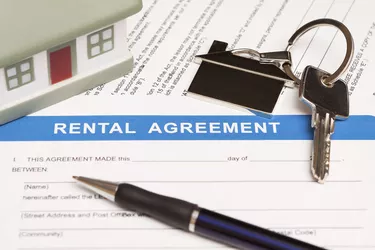
Before a landlord hands you the keys to a rental, you must sign a rental agreement, even if you're only renting short-term. With a month-to-month agreement, tenants pay to live in a house or apartment for at least a one-month period and the landlord or tenant may end the agreement after a relatively short period. By contrast, a lease agreement commits you to renting long-term -- usually for a period of six months or more. Month-to-month rental agreements can prove more convenient than long-term leases in some ways.
Month-to-Month Moving Terms
Video of the Day
Landlords must give a 30-day notice to raise the rent or change other terms of the short-term rental agreement. Depending on state laws and the length of time tenants have lived in the rental, landlords must usually give 30- or 60-day notice to move out. Tenants usually must give at least a 30-day notice before moving out.
Video of the Day
Agreeable Aspects of Month-to-Month Rentals
Month-to-month rental agreements work best for tenants who can't commit long-term or who are unsure of how long they will need the rental. For example, students who rent an apartment during the school year may not want to pay rent during summer vacation, and therefore, opt for a month-to-month agreement. Also, if you need a place to live immediately while you look for a more permanent home to buy or lease, a month-to-month agreement may also be better. You don't have to worry about breaking your lease or owing the landlord several months' rent after you move.
Landlords Like Them, Too
Landlords can make more money with month-to-month rental agreements. Landlords can increase the rent, change rental agreement terms and ask tenants to move with only a 30-day notice. Landlords can more readily take advantage of rising rental rates with a month-to-month agreement because they don't have to wait until their long-term agreements expire to make profitable changes.
Long-term Leases May Turn Monthly
A long-term lease may convert to a month-to-month agreement if tenants decide to continue renting after the initial lease period expires. If tenants don't renew the previous lease or don't renegotiate a new lease, but they remain in the rental, they become month-to-month tenants. This means they can remain in the rental under the same terms as the original lease, but they can move with just a 30-day notice or the landlord may give them only 30 days to move.
Increased Cost for Short-Term Rentals
A month-to-month rental agreement may cost more than a long-term lease. Landlords must advertise and repair a rental for new tenants more frequently, due to increased renter turnaround. This may dip into their profits and result in higher rental rates.